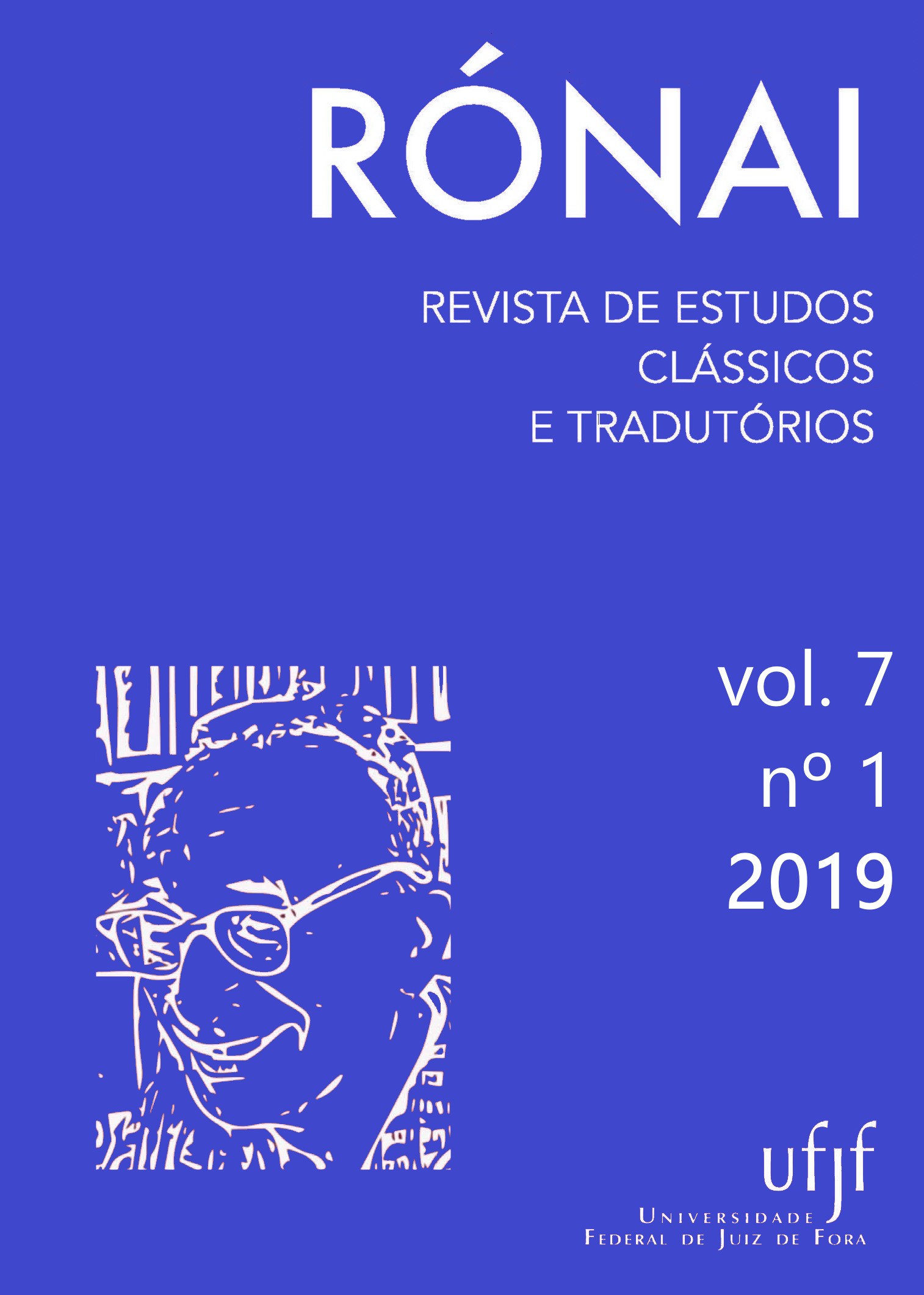Three times Cassandra: fair, seer, tragic
DOI:
https://doi.org/10.34019/2318-3446.2019.v7.27479Keywords:
Cassandra, divination, Homer, Pindar, AeschylusAbstract
For us, the modern readers, the Homeric verses consecrated Cassandra’s beauty and the Pindaric verses, for their turn, acknowledge her as a seer. It is however in Aeschylus’ Agamemnon that the main features of Cassandra’s character are mostly present. This article aims to show three moments in the representation of the Trojan princess – her Homeric, Pindaric and Aeschylean portraits –, stressing in the chosen texts the relation between the character and past, present, and future time.
Downloads
References
Fontes primárias:
AESCHYLUS. Agamemnon. Edited with a commentary by Eduard Fraenkel. 3 vol. Oxford: Clarendon Press, 1982.
ESCHILO. Agamennone. Edizione critica, traduzione e commento a cura di Enrico Medda. 3 vol. Roma: Bardi Edizioni, 2017.
ESCHYLE. L’Agamemnon d’Eschyle. Le texte et ses interpretations. Jean Bollack et Pierre Judet de la Combe. 3 vol. Lille: Maison des sciences de l’homme, 1981.
ÉSQUILO. Oresteia. Estudo e tradução de Jaa Torrano. 3 vol. São Paulo: Iluminuras, 2004.
HOMERO. Ilíada. 2. ed. Tradução de Carlos Alberto Nunes. Rio de Janeiro, Ediouro, 2002 [1945].
_________. Odisseia. Tradução de Carlos Alberto Nunes. Rio de Janeiro, Ediouro, 2001.
OXYRHYNCHUS PAPYRI. Part V. Edited with translations and notes by Bernard P. Grenfell and Arthur S. Hunt. Oxford: The Egypt Exploration Fund., 1908.
PINDAR. Pythian Eleven. Edited with Introduction, Translation, and Commentary by J. P. Finglass. New York: Cambridge University Press, 2008.
PINDARI Carmina cum fragmentis. Pars II. Edidit H. Maehler (post B. Snell). 4a. ed. Leipzig: Teubner, 1975.
SAPPHO ET ALCAEUS. Fragmenta. Edidit Eva-Maria Voigt. Amsterdam: Athenaeum-Polak & Van Gennep, 1971.
Bibliografia de apoio
BOLLACK, J. Le thrène de Cassandre. Revue des études grecques, n. 94, p. 1-13, 1981.
BOUCHÉ-LECLERCQ, A. Histoire de la Divination dans l’Antiquité. Grenoble: Éditions Jérôme Millon, 2003[1879-1882].
BRÜGGER, C. Homer's Iliad: The Basel commentary, Book XXIV. Translated by Benjamin W. Millis and Sara Strack and edited by S. Douglas Olson. Boston; Berlin: De Gruyter, 2017.
CRIPPA, S. Glossolalia. Il linguaggio di Cassandra. Studi italiani di linguistica teorica e applicata, vol. 19, n. 3, p. 487-508, 1990.
DEBNAR, P. The Sexual Status of Aeschylus’ Cassandra. Classical Philology, vol. 105, n. 2, 2010, pp. 129-145.
DE JONG, I. A Narratological Commentary on the Odyssey. Cambridge: Cambridge University Press, 2001.
DE PAOLI, B. A adivinhação na tragédia de Ésquilo. 2015. 416 ff. Tese (Doutorado em Letras Clássicas) – Departamento de Letras Clássicas e Vernácula, Universidade de São Paulo, São Paulo, 2015.
DILLON, M. Kassandra: Mantic, Maenadic or Manic? Gender and the Nature of Prophetic Experience in Ancient Greece. Proceedings of the Australian Association for the Study of Religions Conference, University of Auckland, New Zealand July 6-11, 2008, p. 1-21, 2009.
DOYLE, A. Cassandra: Feminine Corrective in Aeschylus’s Agammemnon. Acta Classica, n. 50, p. 57-75, 2008.
DUMORTIER, J. Les images dans la poésie d’Eschyle. Paris, Les Belles Lettres, 1975.
GOUDOT, M. (Ed.) Cassandre. Paris: Éditions Autrement, 1999.
HARRIS, J. P. Cassandra’s Swan Song: Aeschylus’ Use of Fable in Agamemnon. Greek, Roman and Byzantine Studies, vol. 52, n. 4, p. 540-558, 2012.
HEIRMAN, L. J. Kassandra’s Glossolalia. Mnemosyne, vol. 28, n. 3, p. 257-267, 1975.
IRIARTE, A. Casandra trágica. Enrahonar, n. 26, p. 65-80, 1996.
LEAHY, D. M. The Rôle of Cassandra in the Oresteia of Aeschylus. Bulletin of the John Rylands University Library of Manchester, vol. 52, n. 1, p. 144-177, 1969.
MASON, P. G. Kassandra. The Journal of Hellenic studies, n. 79, p. 80-93, 1959.
MAZZOLDI, S. Cassandra, la vergine e l’indovina: Identità di un personaggio da Omero all’Ellenismo. Pisa/Roma: Istituti editoriali e poligrafici internazionali, 2001.
_________. Cassandra’s Prophecy between Ecstasy and Rational Mediation. Kernos, n. 15, p. 145-154, 2002.
MITCHELL-BOYASK, R. The Marriage of Cassandra and the “Oresteia: Text, Image, Performance. Transactions of the American Philological Association, vol. 136, n. 2, p. 269-297, 2006.
MOREAU, A. Les ambivalences de Cassandre. In: LAURENS, A.-F. (Ed.) Entre hommes et dieux – Le convive, le héros, le prophète. Paris: Les Belles Lettres, p. 145-167, 1989.
NUTTALL, G. F. Cassandra and the Language of Prophecy. The Heythrop Journal, vol. 36, n. 4, p. 512-520, 1995.
RODRÍGUEZ, E. Los lechos de Casandra en “Troyanas” y “Hécuba” de Eurípides y en “Alejandra” de Licofrón. Estudios Clásicos, n. 124, p. 25-46, 2003.
SCHEIN, S. L. The Cassandra Scene in Aeschylus’ Agamemnon. Greece and Rome, vol 29, n. 1, p. 11-16, 1982.
SERRANO, D. de P. Cassandra e le donne tragiche. Myrtia, n. 26, p. 123-139, 2011.
WERNER, C. As performances de Cassandra em Troianas de Eurípides. Letras Clássicas, n. 6, p. 117-133, 2002.
Downloads
Published
How to Cite
Issue
Section
License
Copyright (c) 2019 Beatriz de Paoli

This work is licensed under a Creative Commons Attribution 4.0 International License.
Copyright
The authors of the published contributions agree with the following items:
1. The authors keep the copyright and convey to the journal the right of first publication, the work being licensed under a Creative Commons Attribution License 4.0 International.
2. The authors are allowed and stimulated to publicize and distribute their work online after the publication in the journal, recognizing first publication in this journal.
3. The authors of the approved works authorize the journal to distribute their content, after publication, for reproduction in content indexes, virtual libraries and similars.
For more information about Creative Commons Attribution License 4.0 International, please, go to: https://creativecommons.org/licenses/by/4.0/deed.en
Editorial exemption
The authors of the published contributions are entirely and exclusively responsible for their contents. Its content does not represent an official position of Rónai - Revista de Estudos Clássicos e Tradutórios neither of Faculdade de Letras da Universidade Federal de Juiz de Fora or their partner institutions.



